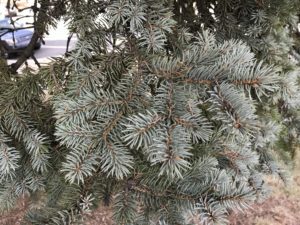THE LEAFLET

Tell the Difference Between Spruce and Pine Trees
Evergreens are usually easy to spot and conifers (trees that bear cones) are even easier to spot (especially when it’s winter!). But drilling down, how to identify conifers further? Here are some tips to tell pine and spruce trees apart.
Like deciduous trees (trees that drop their leaves when it’s cold), conifers can be identified by their leaves, which are not leaves at all, but needles! This is an easy tip to remember: on pine trees, needles are attached and attached to the branches in clusters; on spruce trees, needles are attached individually.
- A longleaf pine – which you can tell is a pine because its needles are attached in bundles.
- You can tell this is a spruce because its needles are attached individually.
We don’t want to say you’ve been lied to your whole life but…the cones that trees produce are not necessarily called pinecones. Not all conifers that produce cones are pines. These cones are built from scales attached to a center stalk – these scales are what can help you differentiate between a pine cone and a spruce cone. Pinecone scales are woody in nature, with a rigid feel. In contrast, spruce cones have thinner scales than pinecones, which gives them a more flexible feel. Be warned though, the length of cones can vary from tree to tree, so the length is not a reliable way to indicate the species of conifer you’re trying to identify.
- pinus strobus “eastern white pine” cone.
- A mature picea pungens “blue spruce” cone. Photo courtesy U.S. Fish and Wildlife Service.
Whether it’s a pine or a spruce we bet it would look good and do good in your yard. Evergreen trees provide shade, privacy, and year-round interest.
 Loblolly Pine | Pinus taeda
Loblolly Pine | Pinus taeda
The loblolly pine is a relatively fast-growing evergreen known for its straight trunk, upright form and distinctive bark. Its narrow form allows it to occupy a variety of yard spaces, and over time its crown of attractive green needles spread out to provide shade below. Loblolly pines need full sun and will attain a height of 40 feet in about 30 – 40 years. You can also get up to $50 back for planting this tree yourself through our tree rebate program.
 Virginia Pine | Pinus virginiana
Virginia Pine | Pinus virginiana
Often used as a bonsai specimen, the Virginia pine is a unique and attractive tree with a sinuous trunk and orange-red bark. It will grow in poor, dry soils. The Virginia pine Requires full sun where it may reach 20 to 30 feet in height in approximately 40 years. This tree is available through our residential planting program, RiverSmart Homes. You can also get up to $50 back for planting this tree yourself through our tree rebate program.



